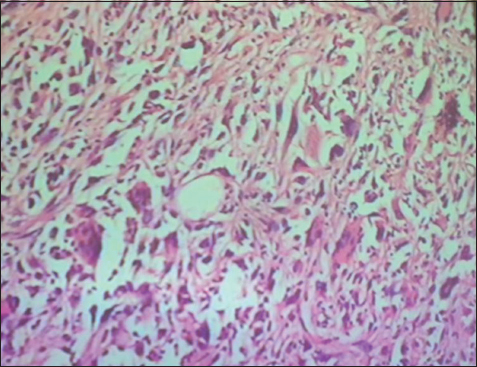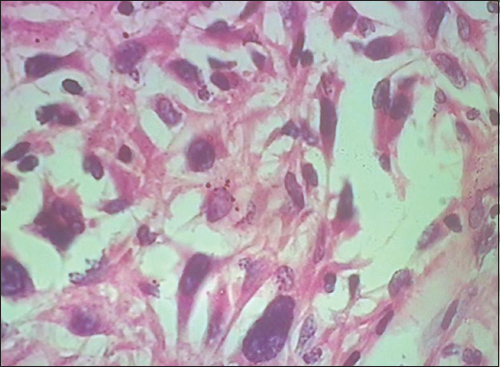Translate this page into:
Undifferentiated pleomorphic sarcoma: Diagnosis of exclusion
Address for correspondence: Dr. Pragati S. Upasham, Department of Pathology, Dr. D.Y. Patil Medical College, Navi Mumbai, Maharashtra, India. pragatisham@gmail.com
This article was originally published by Thieme Medical and Scientific Publishers Private Ltd. and was migrated to Scientific Scholar after the change of Publisher.
Abstract
Malignant soft-tissue tumors which were designated as malignant fibrous histiocytoma are regrouped by the WHO (in 2002) under the new entity termed as “undifferentiated pleomorphic sarcoma.”1 It accounts for less than 5% of all adult soft-tissue sarcomas. Here, we report the lesion in a 70-year-old man who presented with high-grade undifferentiated pleomorphic sarcoma in the lower extremity.
Keywords
Adult soft-tissue sarcomas
malignant fibrous histiocytoma
soft-tissue sarcoma of lower extremity
undifferentiated pleomorphic sarcoma
Introduction
Undifferentiated pleomorphic sarcomas are aggressive tumors, commonly seen in adults. However histopathological pattern is very much variable in these soft tissue malignant neoplasms. We detected this case where proper clinico-histomorphological analysis coupled with immunohistochemistry (IHC) helped us to arrive at a diagnosis.
Case Report
A 70-year-old male presented with swelling over the posterior aspect of the left thigh. Swelling was gradually increasing in size.
Magnetic resonance imaging findings revealed a well-defined altered signal intensity lesion with central area of necrosis in muscular plane of posterior aspect of left mid aspect of thigh involving lateral fibers of biceps femoris.
The patient was subjected to fine needle aspiration cytology [FNAC], the findings of which were suggestive of a soft tissue sarcoma.
Excision of the mass was done and was submitted to us for histopathological examination.
On gross inspection, soft-tissue mass measured 12 cm × 5 cm × 4 cm, with tumor mass of about 3 cm × 2 cm × 1 cm dimensions.
Cut section was gray brown with areas of necrosis in it Figure 1.

- Cut section of the tumor mass
Histopathological examination revealed a malignant tumor with pleomorphic bizarre cells. At places, spindled and tadpole like contour cells were seen. Many histiocytic giant cells were also noted in the sections Figure 23. The surgical margins were free of the tumor.

- H- and E-stained section from the tumor showing histiocytic cells

- Undifferentiated pleomorphic sarcoma: showing anaplastic and variable cellularity
Based on these microscopic findings and the site involved, differentials of pleomorphic rhabdomyosarcoma and an undifferentiated pleomorphic sarcoma were kept. Considering variable histomorphological features, immunohistochemistry (IHC) was suggested.
Immunohistochemistry
IHC showed CD68 and S-110 protein expression in the histiocytes and histiocytic giant cells.
Tumor cells were immunonegative for smooth muscle actin (SMA), desmin S-100 protein, CD34, CK, epithelial membrane antigen, CD68, and glial fibrillary acidic protein (GFAP).
However, no photographs of IHC panel could be obtained as the patient got it done from different institutes.
Comparing all these findings, a concluding diagnosis of high-grade undifferentiated pleomorphic sarcoma was made. Moreover, the patient was referred for oncotherapy line of management.
However, nearly 2½ months later, the patient reported back with a recurrent painful lesion which was excised again.
Pathological findings showed similar gross and microscopic features as the initial lesion Figures 45.

- Gross morphology of the recurrent lesion

- Microscopic features in a recurrent lesion (H and E)
On attempts to know the follow-up, we got the information that the patient had succumbed to the disease, and cause of death informed to us was multiorgan failure.
Discussion
Undifferentiated pleomorphic sarcomas have high incidence of local recurrence and metastasis.1
Accounting for <5% of adult soft-tissue sarcomas,2 these neoplasms have also been reported in children.3
Individuals in the age group of 50–70 years are mostly affected with common site being the lower extremities.4 However, there have been reports of other rare sites involved by these neoplasms such as retroperitoneum4 male breast,5 mediastinum,1 cutaneous,6 and pelvic region.7
Conclusion
These undifferentiated sarcomas are tumors which do not show distinct line of differentiation and obvious morphological features on histopathology. complete workup is recommended to exclude other soft –tissue sarcomas and classify the lesion into this renamed high grade entity.8
Declaration of patient consent
The authors certify that they have obtained all appropriate patient consent forms. In the form the patient(s) has/have given his/her/their consent for his/her/their images and other clinical information to be reported in the journal. The patients understand that their names and initials will not be published and due efforts will be made to conceal their identity, but anonymity cannot be guaranteed.
Financial support and sponsorship
Nil.
Conflicts of interest
There are no conflicts of interest.
References
- Cutaneous metastatic undifferentiated pleomorphic sarcoma from a mediastinal sarcoma. Ann Dermatol. 2015;27:310-4.
- [Google Scholar]
- The evolving classification of soft tissue tumours: An update based on the new WHO classification. Histopathology. 2006;48:3-12.
- [Google Scholar]
- Undifferentiated high-grade pleomorphic sarcomas in children: A clinicopathologic study of 10 cases and review of literature. Pediatr Dev Pathol. 2010;13:209-17.
- [Google Scholar]
- Undifferentiated pleomorphic sarcoma presenting as abdominal pain with a pulsatile mass. Case Rep Surg. 2016;2016:8251043.
- [Google Scholar]
- Undifferentiated pleomorphic sarcoma of the male breast causing diagnostic challenges. J Breast Cancer. 2011;14:241-6.
- [Google Scholar]
- A case of cutaneous malignant fibrous histiocytoma with multiple organ metastases. Kaohsiung J Med Sci. 2013;29:111-5.
- [Google Scholar]
- High-grade undifferentiated pleomorphic sarcoma of the pelvis: A case report and review of literature. Urol Ann. 2016;8:372-6.
- [Google Scholar]
- Sarcoma classification: An update based on the 2013 World Health Organization classification of tumors of soft tissue and bone. Cancer. 2014;120:1763-74.
- [Google Scholar]







